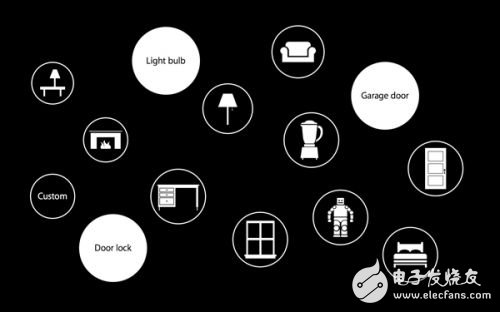I studied the HomeKit released by Apple at the beginning of the month at WWDC, a data communication protocol for smart home accessories. Have a certain understanding of Apple's logic to do this, right or wrong, throw it out and discuss with you.
Apple only manages the software part

My discovery is that Apple does not want to get involved in the hardware part of smart home accessories through HomeKit. It doesn't do central control devices (bridges, repeaters), it is a collection of the functions of the companion iPhone applications of each smart home accessory. , combing and optimization. It's a bit like Apple's handling of Passbook, which is to let you integrate the bills obtained in each ticket-related app into one place. Of course, integrating smart home accessories together can do far more than Passbook.
Therefore, the "fisher's benefit" is the iPhone user, Apple is still creating a user experience around the iPhone, this time extended to everyday life.
Take Philips' Hue smart light bulb as an example. We know that it is connected to the bridge through the Zigbee wireless protocol, and the bridge is connected to the Internet through the wired network port. I mean, HomeKit doesn't change the situation, it just integrates the functions implemented by Hue's iPhone app into the HomeKit protocol. Then Apple is responsible for integrating the functions of the hue bulb and other smart accessories, and then implementing, for example, every night at 12 o'clock, turning off all the lights and windows (upper brands) upstairs, and turning on the multi-device synergy "trigger" like the night light.
This is different from the concept of smart home "control center" that Xiaomi router wants to achieve.
Xiaomi’s ambition is bigger than Apple’s
We know that there are two kinds of networking methods for smart home accessories on the market. One is that the built-in Wi-Fi chip is directly connected to the Internet, and the other is that the accessories are connected through the 433MHz wireless band or wireless network protocol such as Bluetooth or Zigbee. To the central control device, the central control device is indirectly connected by wire or wireless.
In my opinion, Apple's HomeKit only manages the data protocol part of the smart home accessories network. As for how to connect to the Internet, each vendor has different plans for different types of devices, and has nothing to do with Apple. Xiaomi is different. It wants to be the central control device, so that all the accessories are connected to the Xiaomi router first, so that the Xiaomi router can identify what is this device, what can be done, and then connect to the network. In order to allow various accessories to be identified by the Xiaomi router (mainly via Wi-Fi), Xiaomi must be involved in the hardware-level Wi-Fi chip standard-setting process.
Take the BroadLink infrared controller carried by the millet routing public beta as an example. Xiaomi's “route fast connection†function is the router's WPS button (Wi-Fi Protected Setup, Wikipedia), and the BroadLink module's Wi-Fi chip is also connected. Start the WPS function, so the two are connected. Then how does the millet router know that the BroadLink module is connected to the Internet? The visual inspection is based on the ID number of the device (the network card Mac address).
Who is more active?
Of course, in the end, Xiaomi also wants to control a variety of different home accessories in his app. But it's completely different from Apple's way of doing things, and Xiaomi's ambition is even bigger - you can enter my ecosystem by making chips in my way. Apple is like this. If you make products in your own way, just give me a copy of the data according to my standard, I can make iPhone users use your products to be a little bit more cool.
If Xiaomi can make the control center of smart home according to his own wishes, it is obviously better than Apple B. After all, it is a big wish, a "whole solution" of software and hardware. And Apple's solution is even more lazy, just the overall solution on the software, the hardware is allowed to play by the accessory manufacturers.
Who is more fun? I will not hesitate to vote for Apple, because Apple has always known that the true meaning of a perfect experience is not to make a few people feel perfect everywhere, but to make the most users benefit. Think of the Mac Book Air, which is so bad that it makes some people scream, but it is the perfect companion for many people. More rationally, Apple's logic for doing this is based on the hundreds of millions of iPhone and iPad users it has accumulated. Xiaomi needs to first promote a new hardware—the Xiaomi router to the user's home, and then build a hardware and software. The ecosystem, all ideas are based on "if this device uses a millet-certified chip, compatible with the API provided by Xiaomi."
With a correspondingly optimized magnet ring, the brushless motors with iron windings offer a very high torque density and a low cogging torque. The multi-pole internal rotor is extremely dynamic. It has a solid design, with a welded stainless steel flange and housing, making this Brushless DC Motor suitable for a wide range of applications such as rotary actuators, valves, robotic joints and process control.
High Torque Brushless Dc Motor,12V DC Brushless Motor High Torque,Brushless Dc Motor High Torque Low Speed,12V Brushless Dc Motor High Torque Low Rpm
Shenzhen Maintex Intelligent Control Co., Ltd. , https://www.maintexmotor.com
